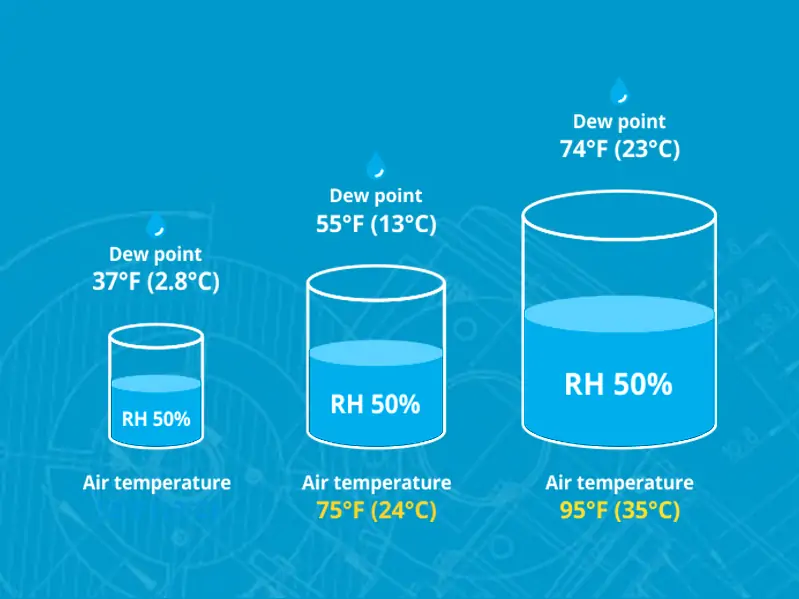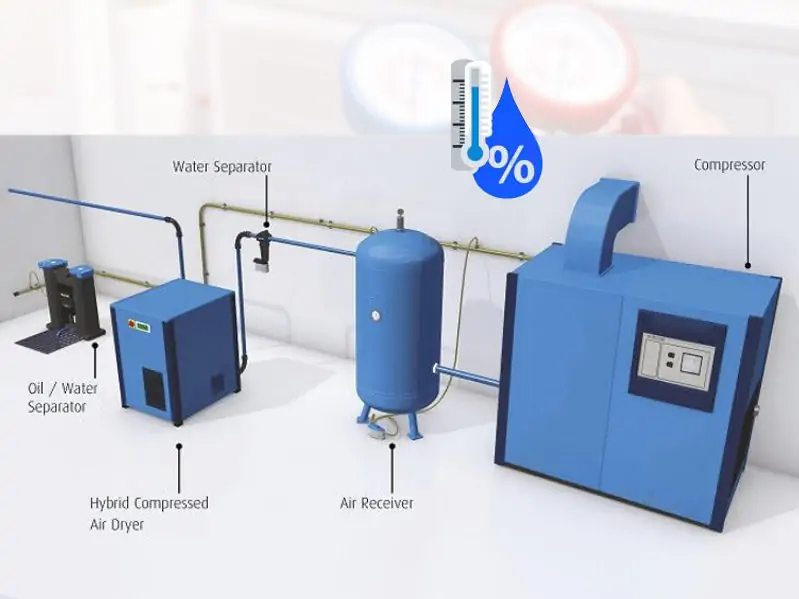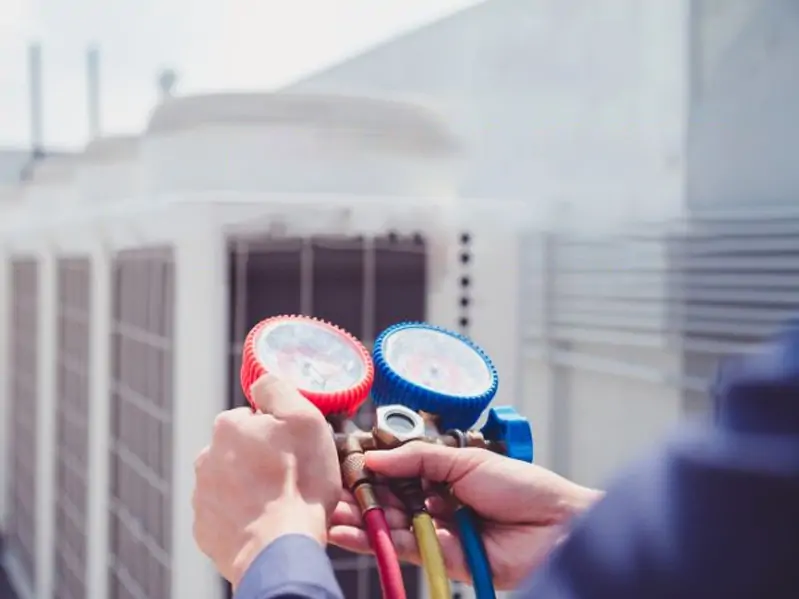Dew point is an important parameter that attracts much attention in the field of air handling and gas engineering. It directly affects the quality and performance of compressed air. Compressed air is used in many applications to supply energy, carry materials, pneumatic transmission and other critical operations. However, the effect of dew point on compressed air is too often overlooked. This can lead to production and process issues, as well as increased maintenance costs.
In this article, we’ll explore what dew point is and how it affects the quality of compressed air. Understanding these key concepts is critical to ensuring the reliability, performance and efficiency of your compressed air system. By gaining a deeper understanding of dew point and its impact on compressed air, we will be able to better optimize our industrial processes and production environments and reduce maintenance costs. This article will help readers gain a more comprehensive understanding of this important topic.
What is The Dew Point?
The dew point is a fundamental concept in thermodynamics and meteorology. It refers to the temperature at which air becomes saturated with moisture. This leads to the condensation of water vapor into liquid water. The dew point represents the temperature at which the air reaches 100% relative humidity. This takes place in the context of compressed air. Moisture begins to condense into liquid form in this state.
Dew Point in Compressed Air
In a compressed air system, the air is drawn from the surrounding environment. This air is then compressed to higher pressures. During this compression process, the air’s temperature increases significantly. As the temperature rises, the air’s capacity to hold moisture also increases. Sometimes the compressed air cools down as it travels through pipes and equipment. Its ability to keep moisture decreases. In some cases, the air temperature drops below the dew point. Here, the moisture will condense within the system.
Significance of Compressed Air Dew Point
Prevent Condensation And Condensation
The dew point indicates the saturation point of moisture in the air. When moisture in the air reaches or exceeds the dew point temperature, the moisture will condense into liquid water. This can lead to condensation on pipes, tools and equipment, causing corrosion, damage and production disruptions. By controlling the dew point of compressed air, these problems can be avoided and equipment and process stability maintained.
Protect Equipment
Moisture and moisture are the natural enemies of many mechanical and electronic equipment. High-humidity air can cause corrosion, electrical shorts, and mechanical failures within equipment. By ensuring that the dew point of the compressed air is below the minimum requirements of the equipment, the life of the equipment can be extended and repair costs reduced.
Improve Process Quality
Many production processes require precise control of air quality, such as automotive painting, food processing, and pharmaceutical manufacturing. If the moisture in the compressed air exceeds permissible levels, it can have a negative impact on product quality. Maintaining proper dew point ensures stable process parameters, thereby improving product consistency and quality.
Energy Saving
Compressed air systems are often one of the major energy consumers in factories and industrial facilities. By effectively managing the dew point of compressed air, energy waste during cooling and heating processes can be reduced. This helps save energy costs and reduce environmental impact.
Safety
In certain applications, high humidity compressed air can be dangerous to the operator and the working environment, such as in the chemical industry. Low dew point air helps ensure operator safety and reduces potential hazards.

Impact of Compressed Air Dew Point
Impact on Equipment
Condensed moisture in a compressed air system can have several negative consequences. These may include a negative start with the equipment itself. Water can lead to corrosion, which can damage pneumatic tools, valves, and piping. Over time, this corrosion can reduce the lifespan of equipment. This leads to increased maintenance costs.
Impact on Product Quality
In some industries, compressed air comes into direct contact with products. In products such as food and pharmaceutical manufacturing, moisture contamination can be disastrous. Moisture can compromise product quality. In some cases, this leads to spoilage, bacterial growth, and reduced shelf life. This can result in product recalls and damage to a company’s reputation.
Impact on Process Efficiency
Moisture in compressed air can also affect process efficiency. It can lead to blockages in pipes, reducing airflow, and impairing the performance of pneumatic tools. This, in turn, can slow down production and increase energy consumption.
Measuring Compressed Air Dew Point
To ensure compressed air quality, it’s crucial to monitor and control the dew point. There are various methods for measuring dew point, each with its advantages and limitations.
Hygrometers
Hygrometers are instruments designed to measure humidity in the air. They work by detecting changes in electrical conductivity. They also detect capacitance and resistance caused by the presence of moisture. Hygrometers can provide accurate dew point measurements. Hygrometers are sensitive instruments that require periodic calibration and maintenance.
Chilled Mirror Hygrometers
Chilled mirror hygrometers are highly precise instruments. They work on the principle of cooling a mirror surface until condensation occurs. They measure the temperature at which condensation forms. These hygrometers can accurately determine the dew point. They are often used in laboratory settings and critical applications. They ensure precise control of moisture levels is necessary.
Infrared Hygrometers
Infrared hygrometers use the absorption of infrared light. This prompts the water molecules to determine humidity levels. They are non-contact instruments. They are suitable for online monitoring of dew points in compressed air systems. Infrared hygrometers offer a good balance between accuracy and ease of use.
Relative Humidity Sensors
Relative humidity sensors are widely used in many applications, including compressed air systems. They provide a cost-effective way to monitor humidity levels. Sometimes they may not be as accurate as some other methods. Regular calibration and maintenance are essential to ensure their reliability.

Controlling Compressed Air Dew Point
Controlling the dew point in a compressed air system is crucial. It helps maintain air quality and prevent moisture-related issues. There are several methods to achieve this.
Refrigerated Air Dryers
Refrigerated air dryers are one of the most common methods for controlling the dew point. This is possible in compressed air systems. These dryers lower the air temperature and condense moisture. It is then drained from the system. They are cost-effective and suitable for a wide range of applications.
Desiccant Air Dryers
Desiccant air dryers use a material, typically silica gel or activated alumina. Such materials help to adsorb moisture from the compressed air. These dryers are capable of achieving extremely low dew points. They are used in applications where even trace amounts of moisture are unacceptable.
Membrane Dryers
Membrane dryers use a permeable membrane to selectively remove water vapor from compressed air. They are compact and require minimal maintenance. This makes them suitable for small-scale applications and remote installations.
Pressure Swing Adsorption (PSA) Dryers
PSA dryers operate by adsorbing moisture on a desiccant material under high pressure. Finally, they release it at lower pressure. This cycle allows them to continuously produce dry air. PSA dryers are energy-efficient. They are suitable for a wide range of dew point requirements.
Maintenance And Monitoring
Once a dew point control system is in place, regular maintenance and monitoring are crucial to its effectiveness. Filters, drains, and desiccant materials must be checked. They must also be replaced as needed to prevent moisture from accumulating. Additionally, monitoring the dew point over time can help identify trends. This tracks the potential issues before they become critical.
Once dew point measurement and control systems are in place, it’s essential to monitor and maintain them regularly. This involves:
1. Regular Inspections
Perform routine inspections of the compressed air system. It’s crucial to ensure that the dew point control equipment is functioning correctly. Any signs of wear, damage, or malfunction should be addressed promptly.
2. Calibration
Calibrate dew point measurement instruments periodically to ensure accurate readings. This will help maintain the integrity of the monitoring system.
3. Filter Replacement
Replace filters and desiccant beds as recommended by the manufacturer. It helps to prevent clogs and maintain the efficiency of the dew point control equipment.
4. Training
Provide training to personnel responsible for operating and maintaining the compressed air system. They should understand the importance of dew point control and how to troubleshoot issues.

Conclusion
The impact of dew point on compressed air quality cannot be underestimated. Moisture in a compressed air system can lead to equipment damage. product quality issues and reduced process efficiency can also start to pop up. It is essential to measure and control the dew point to ensure the highest quality of compressed air. Proper sizing, maintenance, and monitoring of dew point control systems are equally vital. These ensure better maintenance of the integrity and efficiency of compressed air systems. By paying attention to this often overlooked factor, industries can ensure that their compressed air quality remains at its best. Ultimately this benefits their bottom line and product quality.
Maintaining a low dew point not only ensures the longevity of the compressed air system. Longevity also supports product quality and operational efficiency. By using appropriate dew point measurement instruments and control technologies. Companies can achieve these goals and reap the benefits of high-quality compressed air.
Understanding and managing the dew point is essential for optimal performance. The reliability of compressed air systems in industrial applications is an important factor. Investing in proper measurement and control methods will save costs. It will also contribute to better product quality and operational efficiency.
